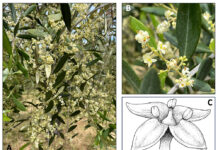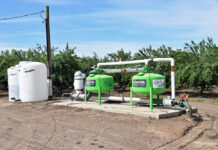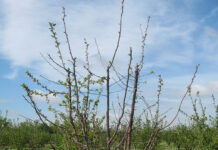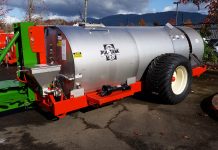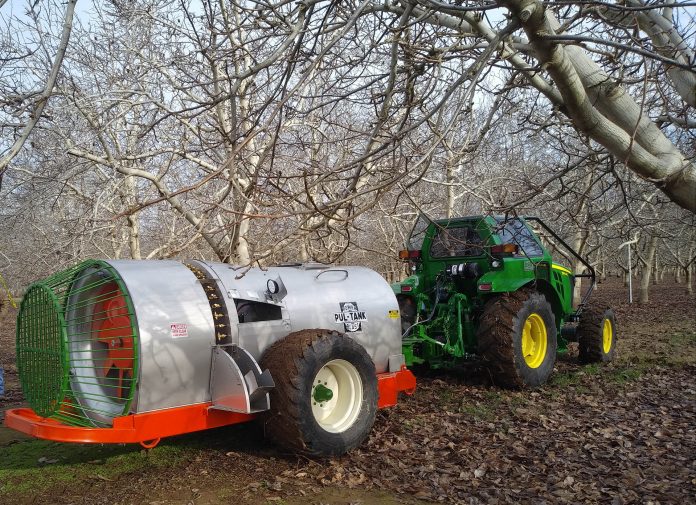
Plenty of factors can contribute to inefficiencies in pesticide spray applications. Complex interactions between equipment, environmental conditions and physical properties of the material being sprayed influence how much of the material hits the target and how much is wasted.
Spray applications in tree nut orchards for pest and disease control are typically done with airblast sprayers. Cost of the spray material and application plus the potential loss of crop yield from pests and disease make achieving high target deposition and coverage critical.
Dr. Peter Larbi, assistant UCCE specialist in the Agricultural Application Engineering program (AgAppE Lab) at the Kearney Agricultural Research and Extension Center in Parlier, spoke on the components of a good spray application at the 2020 UC Pistachio Day. Larbi is also working on an Expert System model for spray applications to help growers achieve optimum spray coverage. Larbi said that significant material loss can result from drift and ground fall out because of variability in tree canopy profile and size. Lack of calibration and maintenance of spray equipment and operator error also contribute to spray inefficiency. Material that does not contribute to pest or disease control represents a production cost without a return, he said.
Spray Application Basics
Airblast sprayers use high volume, high velocity air to transport spray material. They atomize the tank mix liquid and the fan air transports the droplets toward the target. Atomization produces a spray consisting of a spectrum of droplet sizes. Three things can happen to the droplets: they can drift beyond the canopy, they can hit the ground, or they can be intercepted by the tree canopy, i.e. they can hit the target. Research in citrus has shown that 18 to 26 percent of applied spray material is generally off-target. Six to 14 percent is lost to drift, 9 to 20 percent hits the ground.
Environmental factors, such as wind, air temperature and humidity can negatively affect the efficiency of the spray application. Added to those are improper operating settings of the airblast sprayer, including nozzle design, operating pressure and the physical properties of the tank solution.
Maintenance of the sprayer is critical for proper function, Larbi said. Parts, including the agitator in the tank, pressure gauges, pumps, nozzles and fan must be operating correctly.
The rate and speed of the airflow also determine how much of the spray material reaches the target. These factors must be managed with the tree canopy size and foliage density in mind.
The operator of the sprayer is one of the primary arbiters in an effective application. This person should be trained and knowledgeable about sprayer operation, be familiar with and follow best management practices, be attentive to the machinery and respond quickly when a problem arises.
Accurate Calibration
The airblast sprayer must be calibrated accurately to deliver the material. Calibration should be done at the beginning of the spray season and changes made when conditions, such as foliage density, warrant. Larbi noted that not all calibration steps are always necessary. Adjustments can be made to the components of the sprayer that are affected by the change in conditions.
The spray application must be timed according to weather conditions and to the target pest for best control. The spray must be directed at the target canopy and adequately penetrate the canopy for optimal coverage. If in excess, penetration can lead to spray droplets exiting the target canopy without depositing on it.
It is important, Larbi said, to take into account specific orchard conditions before starting a spray application. Adjustments in fan speed, ground speed and nozzles can achieve better efficiency. Making sure the droplets hit the target and are being retained there is important, and different situations may call for changes in the tank mix formulation, including the use of adjuvants to improve deposition. Target coverage can be assessed with the use of spray cards (see Larbi’s related article on March/April 2020 edition of Progressive Crop Consultant magazine for details.) These can show if the spray made it to the target, but do not show deposition.
Expert System Model
Modeling and simulation tools developed by Larbi focus on efficiency – which is the amount of spray material reaching the target versus the amount of spray delivered by the airblast sprayer. Efficiency entails spray deposition. Larbi’s spray evaluation section of the Expert System can be used to simulate several different spray application scenarios by changing values of inputs and observing spray deposition. These scenarios may represent different optional settings a grower could use in the application. By comparing the outcomes—on-target deposition—of the various settings, the grower can identify the setting that would result in optimum spray material deposition.
Computer modeling utilizes the tree characteristics, application parameters, weather and orchard conditions to develop the optimal settings. Larbi said that validating a model with data from an actual field experiment provides confidence to trust the model’s predictions and to make decisions based on the model.
Tree height, foliage density, and canopy diameter are the tree characteristics. Application parameters are the airflow rate, nozzle type and number of nozzles, operating pressure and ground speed. Temperature, relative humidity and wind are the weather parameters. Orchard conditions include number of trees per row, tree and row spacing and missing trees. Other parameters in the modeling are output per side, total volume applied, total area covered, application rate and number of trees sprayed.
Using the model, inputting the parameters of the sprayer application and orchard design, is one way of improving the efficiency of the spray operation. In contrast, Larbi said that guessing the outcome of an airblast spray application for its canopy deposition, drift and ground fall-out is almost impossible.
Modeling the simulation tools for predictions can improve decision making for better planning, Larbi said. CitrusSprayEx or similar tools can help. For more information on the Expert System, go to ucanr.edu/sites/CSEESDeploy/CitrusSprayEx_Resources/.



